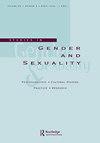The Women of Get Out: Femininity, Race, and Betrayal in the Contemporary Horror Film
Q3 Social Sciences
引用次数: 2
Abstract
ABSTRACT Jordan Peele’s horror film Get Out (2017) has been generally acclaimed for its unflinching critique of American racism, made even more notable by the East Coast, liberal-elite setting of the film. While the film commendably organizes its mainstream horror narrative around an African American male protagonist, the film’s depiction of femininity has proven controversial. This essay explores the gender politics of the film’s depiction of women, especially but not exclusively its White female characters. Drawing on perspectives from psychoanalytic theory, intersectionality, and feminist horror studies, the essay considers the film’s reworking of Carol Clover’s figure of the “Final Girl” who alone survives the horror movie bloodbath. The function of Peele’s Final Girl is less clearly positive, given that this figure is the film’s ultimate villain. The essay explores intersections between the film and psychoanalytic attitudes toward female caregivers who fail to conform to gendered standards, theorizing that betrayal emerges as a significantly gendered concept. Get Out unusually depicts maternal loss as a central aspect of its male protagonist’s psychology while also foregrounding maternal and other forms of female betrayal.《脱身》中的女性:当代恐怖电影中的女性、种族与背叛
乔丹·皮尔(Jordan Peele)的恐怖片《逃出绝命镇》(2017)因其对美国种族主义的坚定批判而广受赞誉,而该片以东海岸的自由主义精英为背景,更是引人注目。虽然这部电影围绕非裔美国男性主角组织的主流恐怖叙事值得称赞,但影片对女性气质的描述却引起了争议。本文探讨了电影中对女性的描述,尤其是但不限于白人女性角色的性别政治。从精神分析理论、交叉性和女权主义恐怖研究的角度出发,本文考虑了这部电影对卡罗尔·克洛弗(Carol Clover)在恐怖电影大屠杀中独自幸存下来的“最后的女孩”形象的改造。皮尔饰演的“最后的女孩”的作用就不那么积极了,因为这个角色是影片的终极反派。这篇文章探讨了电影和精神分析对不符合性别标准的女性看护者的态度之间的交集,并提出了背叛作为一个明显的性别概念出现的理论。《逃出绝命镇》不同寻常地将母性丧失描绘为其男主角心理的中心方面,同时也突出了母性和其他形式的女性背叛。
本文章由计算机程序翻译,如有差异,请以英文原文为准。
求助全文
约1分钟内获得全文
求助全文
来源期刊

Studies in Gender and Sexuality
Social Sciences-Gender Studies
CiteScore
0.80
自引率
0.00%
发文量
15
期刊介绍:
Beginning in the final two decades of the 20th century, the study of gender and sexuality has been revived from a variety of directions: the traditions of feminist scholarship, postclassical and postmodern psychoanalytic theory, developmental research, and cultural studies have all contributed to renewed fascination with those powerfully formative aspects of subjectivity that fall within the rubric of "gender" and "sexuality." Clinicians, for their part, have returned to gender and sexuality with heightened sensitivity to the role of these constructs in the treatment situation, including the richly variegated ways in which assumptions about gender and sexuality enter into our understandings of "normality" and "pathology."
 求助内容:
求助内容: 应助结果提醒方式:
应助结果提醒方式:


